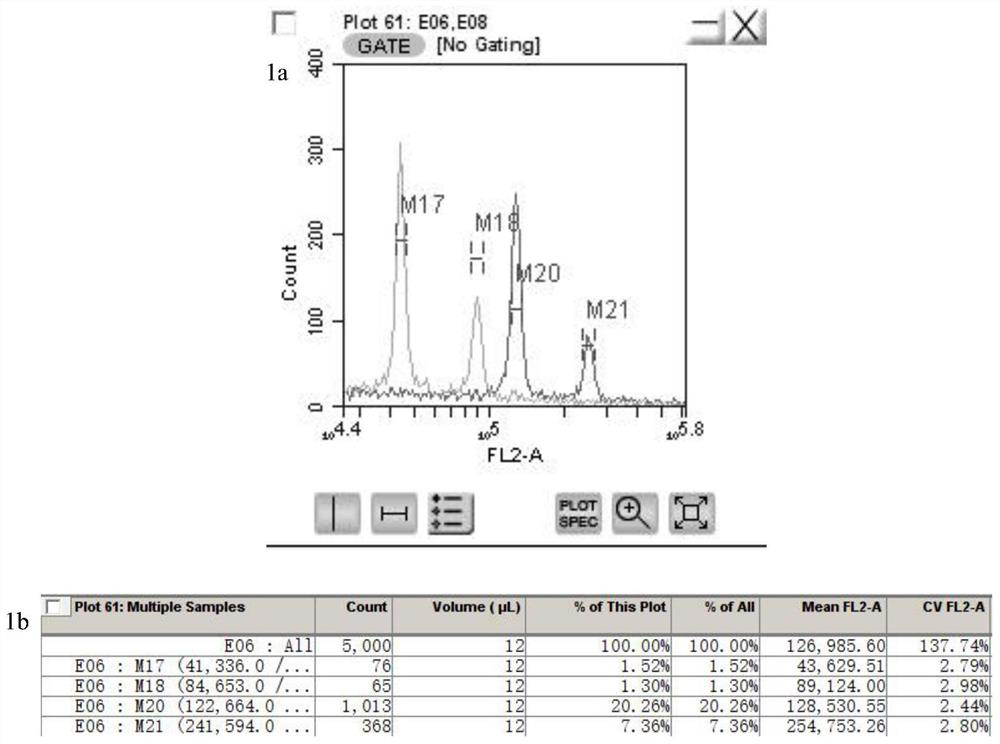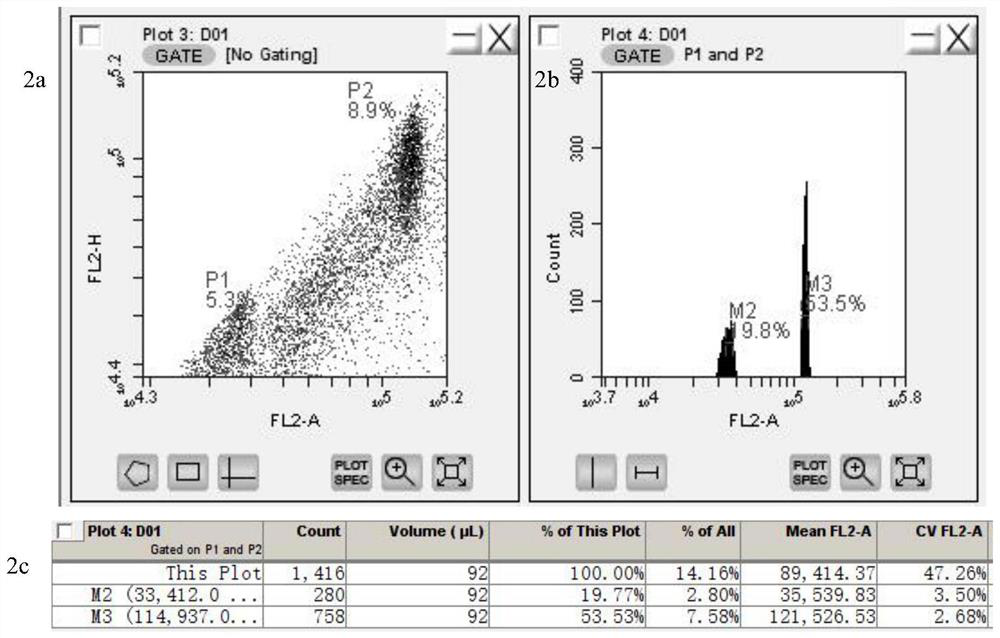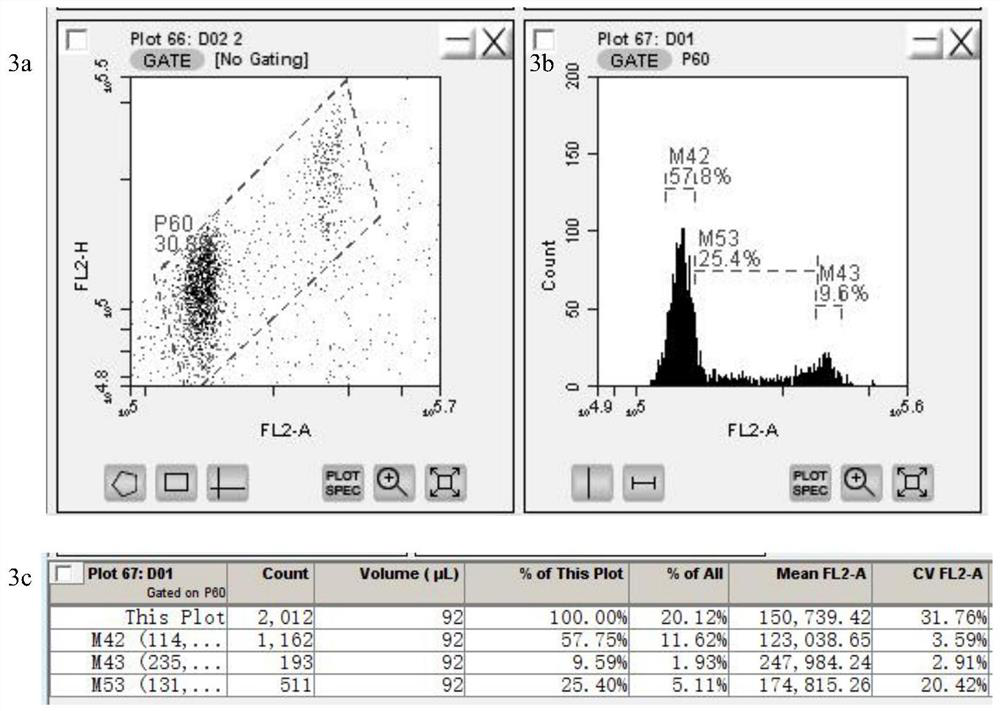A method for rapidly identifying the genome size of sweet potato and its application
A genome and sweet potato technology, applied in the field of plant ploidy detection, can solve the disputes over the size of the sweet potato genome, the inability to meet the accuracy requirements of the sweet potato genome, browning, deterioration and death, etc.
- Summary
- Abstract
- Description
- Claims
- Application Information
AI Technical Summary
Problems solved by technology
Method used
Image
Examples
Embodiment 1
[0049] The test sample is: mixed sample of Xu Zishu No. 8 and Trilobed Petunia-1
[0050] Sampling in the field: Take samples from the field and keep only 10 parts of the 10cm stem tip of the unexpanded leaves. Try to take the samples in the morning or evening. The cuttings are placed in an aeroponic box (100cm×60cm) prepared in advance with 30L of Hoagland’s culture medium ×40cm). Hoagland's culture solution is prepared with deionized water. When cutting, pay attention to rinse the sample with deionized water to remove browning wounds and tissues. Avoid mechanical damage to tender tissues when sampling. When sampling, ensure that the sample to be tested is virus-free, pest-free and robust.
[0051] Slow rooting of seedlings: immerse the 5 cm stem section of the cutting sample in the culture solution, and take 50 mg of young unexpanded leaves after 1 day for testing.
[0052] Cracking: Take 50 mg young stems and leaves, and the materials to be tested (when taking leaves, pa...
Embodiment 2
[0060] The test sample is: mixed sample of Xushu 18 and rice Nipponbare
[0061] Sampling in the field: Take samples from the field and keep only 10 parts of the 10cm stem tip of the unexpanded leaves. Try to take the samples in the morning or evening. The cuttings are placed in an aeroponic box (100cm×60cm) prepared in advance with 30L of Hoagland’s culture medium ×40cm). Hoagland's culture solution is prepared with deionized water. When cutting, pay attention to rinse the sample with deionized water to remove browning wounds and tissues. Avoid mechanical damage to tender tissues when sampling. When sampling, ensure that the sample to be tested is virus-free, pest-free and robust.
[0062] Slow rooting of seedlings: immerse the 5cm stem section of the cutting sample in the culture solution, and take 50mg of young young roots for testing after 1 day.
[0063] Lysis: take 50 mg of young young roots, the material to be tested, wash the surface dust with distilled water, blot ...
Embodiment 3
[0070] Test sample: Xushu 18
[0071] Field sampling: only keep 8 parts of the 10cm stem tips of unexpanded leaves from the field sampling, try to take the samples in the morning or evening, and put the sample cuttings in the aeroponic box (100cm × 60cm) prepared in advance with 30L of Hoagland culture medium ×40cm). Hoagland's culture solution is prepared with deionized water. When cutting, pay attention to rinse the sample with deionized water to remove browning wounds and tissues. Avoid mechanical damage to tender tissues when sampling. When sampling, ensure that the sample to be tested is virus-free, pest-free and robust.
[0072] Slow rooting of seedlings: immerse the 4cm stem section of the cutting sample in the culture solution, and take 50mg of new root tips after 1 day for testing.
[0073] Lysis: Take 50 mg of newborn root tips, wash the dust on the surface with distilled water, blot the surface moisture with filter paper, put it into a pre-cooled sterile petri di...
PUM
| Property | Measurement | Unit |
|---|---|---|
| length | aaaaa | aaaaa |
Abstract
Description
Claims
Application Information
 Login to View More
Login to View More - R&D
- Intellectual Property
- Life Sciences
- Materials
- Tech Scout
- Unparalleled Data Quality
- Higher Quality Content
- 60% Fewer Hallucinations
Browse by: Latest US Patents, China's latest patents, Technical Efficacy Thesaurus, Application Domain, Technology Topic, Popular Technical Reports.
© 2025 PatSnap. All rights reserved.Legal|Privacy policy|Modern Slavery Act Transparency Statement|Sitemap|About US| Contact US: help@patsnap.com



